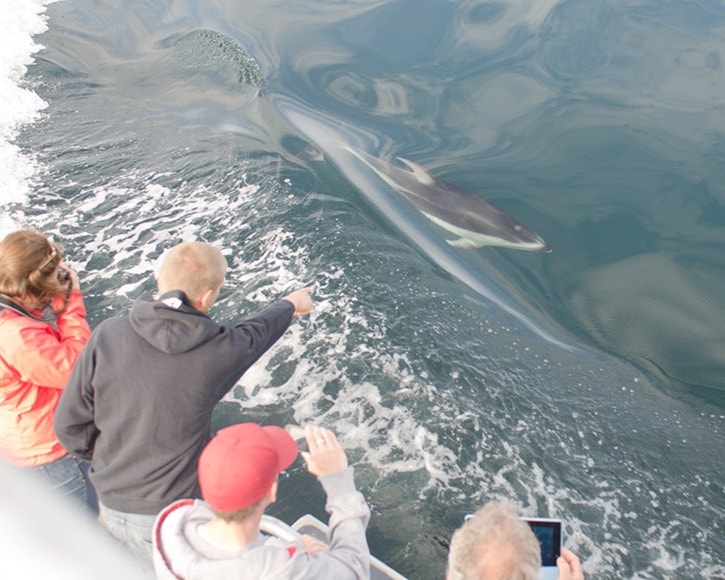Elena Rardon
Gazette staff
TELEGRAPH COVE—Even without the whales, a trip out with Stubbs Island Whale Watching is always an experience.
I went out on Father’s Day weekend for a trip on the Telegraph Cove-based company’s new catamaran and found the weather working in my favour. The water was smooth and calm, the clouds occasionally parting for the sun, which made viewing conditions nearly perfect as we stepped aboard the Kuluta. The expedition drew a mix — those of us from Port Hardy and Port McNeill were whale-watching veterans, while others had come from as far as Ontario and Quebec. One couple even harkened from Switzerland. The group of twenty felt small for the boat’s 40-passenger capacity. The catamaran is smaller than the company’s other boat — the Lukwa — but the Kuluta makes up for it with plenty of viewing areas, including a large sun deck. Passengers explored the boat, including the heated cabin where we were provided with coffee, tea, and snacks for the journey.
The crew was friendly and inviting, starting with Captain Geoff Dunstan. Dunstan, who was born and raised in Campbell River, where he worked as a sport fishing guide before he got into whale watching, is working his third season with Stubbs. He introduced us to Roger McDonell, the co-owner of Stubbs Island Whale Watching, as well as marine naturalist Alison Ogilvie. Also from Campbell River, Ogilvie graduated from UVic with a degree in marine biology in December, and discovered a posting for the job online.
“My job is to make sure everybody knows what’s out there,” said Ogilvie, who was rarely spotted without a pair of binoculars or a binder full of facts about marine life.
She also has other critical duties on board.
“Direct any questions about the washrooms to Alison,” McDonell joked. “She’s the one who has to clean them.”
The boat started up quietly, but delved into a low roar as we moved out into the open water, twin sprays of water firing up from the propellers at the back of the boat. The spray, and the noise, came from the catamaran’s surface piercing drive - a new feature that means all the sound created by the propellers is spread across the water’s surface.
McDonell said it was this surface piercing drive that made the boat very attractive when they made the decision to purchase it from a downsizing whale watching company in Victoria. Orcas are very acoustic animals, and the new boat makes no sound underwater.
“It was virtually built and designed for whale watching,” McDonell said.
The boat’s name was chosen after the company held a contest on its Facebook page, drawing almost 170 entries. “We wanted a name that was easy to say on the radio, but also relative to the industry,” said McDonell. The winning entry, submitted by a UVic student familiar with the area, is the Kwak’wala word for “porpoise.”
Within the first hour of the trip, we spotted the dark humps of Dall’s porpoises rising out of the water. Shortly after, a Pacific white-sided dolphin did a little flip and we were almost immediately surrounded by the creatures. The dolphins began to bow ride, surfing in the waves created by the boat. We spread out across the viewing platform, wielding cameras, video recording equipment and iPads. Even McDonell carried a camera, taking pictures for the company’s online travel log.
“You guys and your cameras,” one passenger complained good-naturedly. “You’re missing out on the experience!”
The dolphins continued to bow ride, until we were forced to stop and drift in an attempt to dissuade them. “The dolphins will harass the humpbacks,” McDonell explained as they circled the boat. “I love the dolphins, but sometimes they’re like pesky mosquitoes.”
But even after the dolphins were gone, the humpbacks remained out of sight. We saw a group of harbour seals sunning themselves on the rocks, then got up close to a spread of Stellar sea lions, who noisily pushed each other off the rocks, to the entertainment of many passengers, who cheered on combatants from the sun deck.
As the trip drew to a close, we gathered in the seating area to listen to a presentation on the animals we had seen—and some we hadn’t.
“Our goal is to inspire hope and positive change,” Ogilvie said. “The most important thing to take away from this trip is that you, too, can make a difference.”
Although we didn’t see any whales before we docked that afternoon, no one was disappointed. Passengers gathered during the ride back to share photos and videos they had collected along the way. “I’d call it a successful trip,” Ogilvie said.
For your next visit to Telegraph Cove, consider stepping off dry land for a trip out with Stubbs. With a friendly crew and a comfortable boat, you can discover more about the underwater world that surrounds us.
